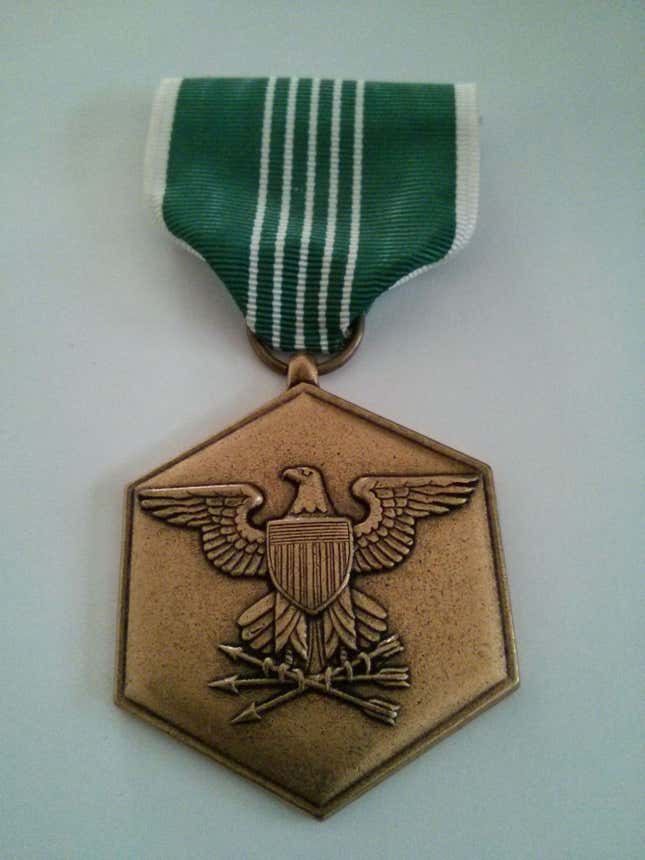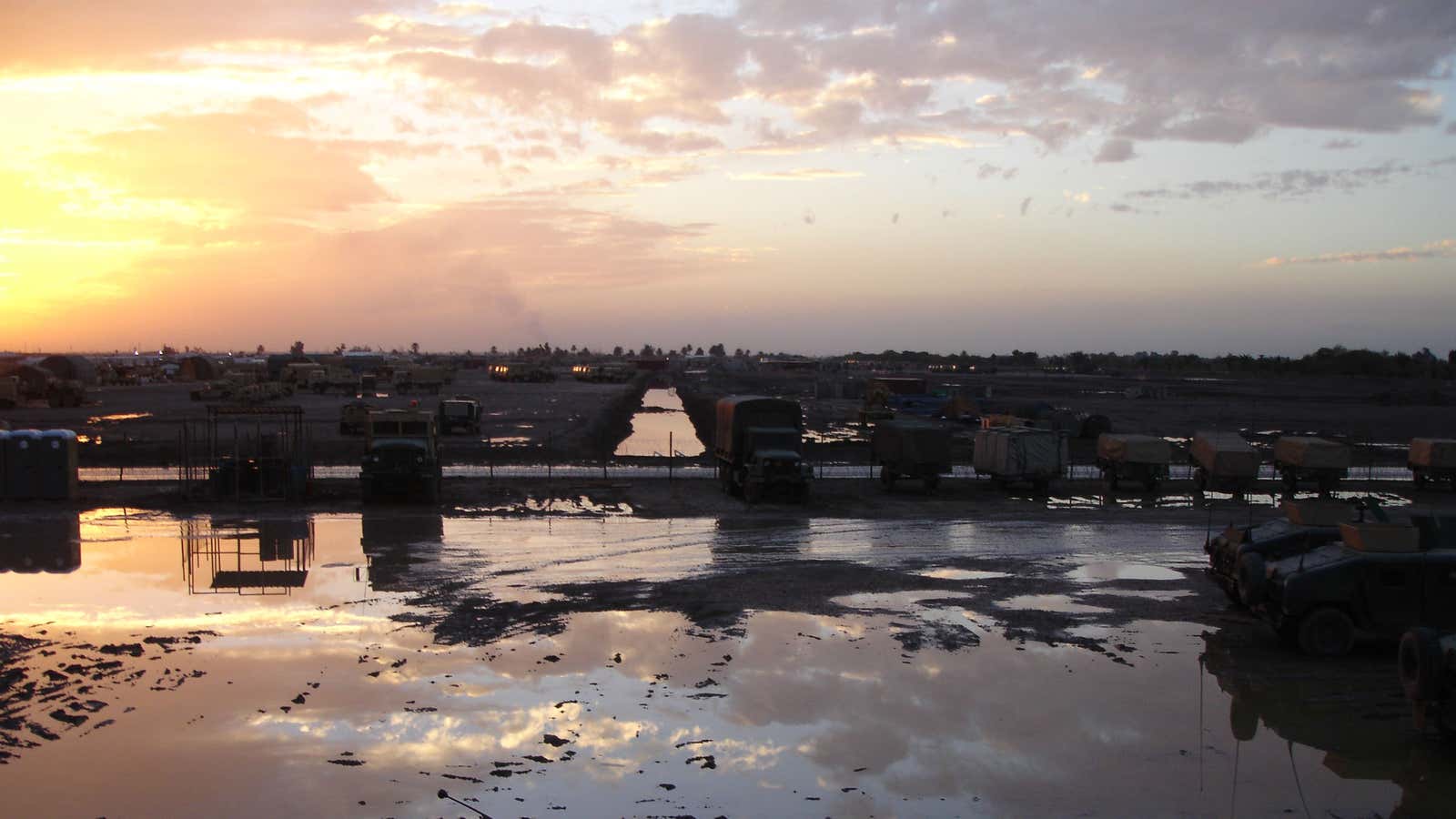In 2005, my National Guard unit was deployed to Iraq as part of Operation Iraqi Freedom. My MOS (Military Occupational Specialty) in the Army was 92A, which is basically a logistics and supplies specialist. My job was to order parts for mechanics, pick them up, return old parts, manage HAZMAT, dispatch and return vehicles from missions, and handle licenses. I also did a few other things that I don’t remember right now.
At the time, the heart of this system was a tool called ULLS-G (Unit Level Logistics System—Ground). Shortly after we came back, ULLS-G was replaced by SAMS-E (Standard Army Maintenance System—Enhanced), which incidentally uses Oracle as a back-end database. Compared to SAMS-E, ULLS-G was a dinosaur. I had used it quite a bit, of course, having been in the Army for about four years by the time I was deployed. It was a complete pain. ULLS-G was a DOS application (yes, MS-DOS) and most of the computers I used it on at the armory were only running DOS (this was early 2000s so it wasn’t too uncommon to still see DOS systems around). By the time I was deployed most computers were running WinXP/2K or something like that, and you could run ULLS-G in “MS-DOS compatibility mode.”
You couldn’t really use the mouse in ULLS-G, since it was written for use in DOS. All interaction was via the keyboard. Part of what made the system so horrible was that there was no batch functionality of any kind. So let’s say you had to print out licenses for soldiers in your unit. You had to go through and print out each license one by one. You’d go to a screen to load up a user’s license by entering their license number, and then you had to print it. Our unit had around 150 soldiers, so to print everyone’s licenses, I had to individually look up each soldier and then print his license. If you had to add a vehicle qualification for soldiers, you also had to do this individually. Normally this isn’t so aggravating, since you only have to deal with a few qualifications at a time, but we were a unit that specifically stood up for this mission (our soldiers all came from four different batteries), which meant that our ULLS-G system had no information about soldiers’ qualifications.
Initially, I had to manually input each soldier’s qualifications and then print out their license. This would basically take me the better part of an hour to go through 150 or so soldiers. In true Army fashion, it gets even worse. Before we left, we had pre-mobilization training at Fort Lewis, Washington. There was a lot of vehicle training that our soldiers had to go through, and after each training mission I had to add qualifications and reprint licenses.
Needless to say, I was annoyed. I even got word that when we were finally in-country, there were going to be more vehicle qualifications which meant that I would have to add qualifications and print out licenses all over again. Now as a programmer, I’m constantly looking for ways to make my job easy. I didn’t want to sit and add qualifications, and print licenses one by one. I was too lazy for that, and worse, the whole thing was horribly inefficient. So I decided to figure out how to automate the process.
The first thing I tried to do was to figure out the format of the ULLS-G data files. I wasn’t able to do that at all, mainly due to lack of time (what with all the military training going on). But then, quite serendipitously, I stumbled across a page where someone had posted a driver that would allow me to run automated queries for the database. By the time we had reached Iraq, I had a working script that generated licenses as text files for all the soldiers. The script only took a second or two to run, and the longest part of the process was simply printing out the licenses. But I wasn’t done yet. I was still annoyed that I would have to add driver qualifications manually. So I wrote another script that would go and add qualifications to drivers en masse. The script even had a configuration file where you could specify what qualifications you wanted to add and to whom.
When we finally reached our unit, I had to print out everyone’s licenses again. I still remember my Motor Sergeant looking perplexed when I showed up in 20 minutes with a warm stack of licenses, still fresh from the printer. “Didn’t this take you a lot longer before?” he asked. I started talking about the script but he just tuned me out after about three or four technical words and took the licenses to the tactical operations center. In a way, it was good he didn’t ask me too many questions, because what I was doing wasn’t really sanctioned. Only licensed technicians (there is another MOS for that) are allowed to mess with the ULLS-G install, and I wasn’t technically qualified, at least in the Army’s eyes.
After we were in Iraq, I also found out that we had to send up daily reports to our TOC (who would then send it up to battalion). These reports consisted of the state of our vehicles (whether they were dead-lined or good to go) and various other bits of information. Pretty much every other unit there typed up all this information manually in an Excel spreadsheet, and then printed it out and took it to the TOC. As a result, there was always room for errors. Every morning I would have to spend 20-30 minutes fixing the report and making sure that it was up to date, before I printed it out and sent it to the TOC. I remember getting yelled at once or twice because I had the wrong information there, and so after that I was doubly careful.
Again, I was starting to get annoyed. There had to be a better way to do this, and there was. I simply used that same connection I had used for the licenses with a nifty Excel macro that populated all the fields in our spreadsheet. It was pretty neat. It would automatically update the list of dead-lined vehicles and it also included other information that other units didn’t report, like the service status of all our vehicles and their mileage as well. The service status bit was especially useful even on a day-to-day basis since previously we had to manually look up each vehicle’s service status when it was returned from dispatch. Now I simply had to look it up in a spreadsheet and it would show me at a glance which vehicles required servicing.
From a programming standpoint, what I did wasn’t all that stellar. I had simply figured out a way to grab information out of the ULLS-G database. But my leadership was very impressed, especially my squad leader and my motor sergeant. Around 2-3 months after we had already been in country, we had a new battalion motor officer showed up (CW2 Lee, if I recall correctly). He was very curious about what I had done. Once I had demo’d it to him, he looked at me and said “You know you’re not supposed to be doing this, right?” I was initially scared that I was going to get in serious trouble, but he had a smile on his face. He told me that he didn’t mind because it seemed like I knew what I was doing and the end result was that I was helping my unit out by being efficient and by providing accurate reporting.

The next few months passed and soon we were only a month or two away from getting out of Iraq. My scripts and macros had been running with only minor hiccups here and there. Toward the end, we had an awards ceremony. The commander and first sergeant came over to the motor pool to hand out awards. I was kind of surprised to be called up because I wasn’t expecting one (my job mainly kept me on base; I did my job well I thought, but I didn’t think it was award worthy. There aren’t too many ways to really excel at supplies and logistics). After awarding me the Army Commendation Medal, both he and the first sergeant shook my hand and congratulated me. I thought it was just a generic “good job” award until I saw the paperwork. When I read through the paperwork, I saw that my squad leader SSG Lopez had put me in for the award based on the work I had done with the Perl scripts and the Excel macros. I was surprised and elated. Although I didn’t work on any of it for recognition, it’s still a good feeling when you find out that your work is appreciated.
